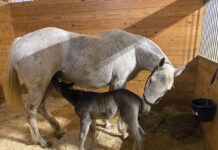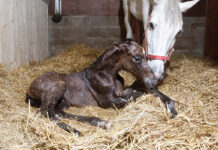 The big day is just around the corner! Your long-awaited foal is about to arrive. By this time, you’ve decided where your mare will foal and have prepared the area, whether it is a stall or small paddock. If you plan to let the mare foal outdoors, you should have a securely fenced, lighted paddock with non-climb fencing to keep the mare and foal safely enclosed and dogs or predators out. Ideally, the paddock should be grass rather than dirt; don’t use the area until foaling so it’s free of manure and urine spots.
The big day is just around the corner! Your long-awaited foal is about to arrive. By this time, you’ve decided where your mare will foal and have prepared the area, whether it is a stall or small paddock. If you plan to let the mare foal outdoors, you should have a securely fenced, lighted paddock with non-climb fencing to keep the mare and foal safely enclosed and dogs or predators out. Ideally, the paddock should be grass rather than dirt; don’t use the area until foaling so it’s free of manure and urine spots.
The typical equine pregnancy lasts 343 days, or a little over 11 months. Gather your supplies and have them ready well before the mare’s due date so you have everything you may need.
To ensure your foaling supplies are in order, use this handy checklist:
Foaling Supplies
- Terry cloth towels—bath towel or half-size bath towels
- Stainless steel bucket
- Liquid soap such as Ivory, Dawn or Joy
- Roll cotton
- Baling twine or strong string
- Scissors
- Enemas (any enema safe for children is fine; a phosphate enema is best)
- Tincture of iodine* or Nolvason solution for dipping navels
- Small containers or 60 cc plastic syringe cases (for dipping foal’s navel)
- Umbilical clamps or rubber bands (if foal’s navel bleeds more than normal)
- Obstetrical sleeves or plastic rectal sleeves
- Disposable tail wrap or gauze bandage for wrapping tail
- Disposable latex gloves
- Obstetric lubricant or K-Y Jelly (not mineral oil)
- Small blanket or old down vest (should you have to keep the foal warm on a cold night)
- Flashlights & batteries (in case of power failure)
- Cell phone or cordless phone
- Phone numbers of vets, experienced foaling person (post near phone!)
* If you decide to use iodine to dip the navel, ask your vet which strength he or she recommends. Some vets use 2 percent; others prefer the stronger 7 percent iodine.
Watch for these changes in your mare, which indicate signal she is getting closer to foaling:
- Udder fills out and become more dense
- Muscles over croup and tail head loosen and relax in preparation for birth
- Mucus discharge (a small amount of dense white or off-white colored mucus plug)
- Restlessness, pacing, pawing, change in behavior
For a Print-Friendly Checklist, Click Here»
Further Reading
Be Prepared for Foaling Season
Newborn Foal Care






USEFUL,NEAT,CLEAN,HANDY!
Don’t forget that some mares leak milk shortly before giving birth.
This is awesome!! I will print this out as a reminder to be prepared.
Thanks
This article was very helpful. My mare is going to foal in June 08 and this is my first foal and it is very helpful to have this. Thankz great article!
Thanks for the info. this is our first time and we were not sure really what we needed. now we have a good idea of what to get
Thanks for the article!
good info
Very informative article
Your checklist sounds great, you need a tetanus shot though added to your list. I have also found that with a newborn foal, that if you buy LIQUID children’s vitamin and give them about 10cc that their appetite is a lot better when they stand to nurse. Remind your viewers that they are not to help the foal stand, the foal’s hooves must harden before they will support any weight.
A thermometer would be good for this list also. An increase in temperature can be a sign of infection for both mare and foal. Foals are also more prone to hypothermia…
this is a good checklist to have handy to use for yourself or to give it to a friend who has a pregnant mare.
This has lots of good information that you would need to know.
good information
This was so handy. Thanks for the awesome advice!!!
This checklist was very helpful